INTRO:
Basketball and Nike shoes are not the exactly the kinds of things that one would expect to gel with the gameplay of JRPGs (the acronymic slang for “Japanese RPGs”).
The game by indie developer Tales of Games that is long-windedly titled “Barkley, Shut Up and Jam: Gaiden” would try to do this. It deliberately fails spectacularly, awkwardly and most importantly, humorously. (Do pardon the judicious use of adverbs.)
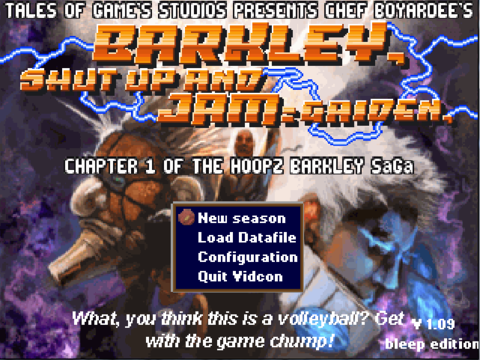
PREMISE:
Shut Up and Jam: Gaiden is intended to be a sequel of sorts to not only the actual Barkley Shut Up and Jam games, but also the animated film Space Jam.
Already, an astute person may notice that the game is likely infringing on more than a few copyrights and trademarks, albeit very old ones. That is in addition to the obvious recycling and remixing of assets from older Final Fantasy games, when they were still using 2D graphics and sprites.
It is therefore quite an amusing wonder that the game has not been hit with a cease-and-desist charge, though this was perhaps due to its relatively low profile and its freeware status.
Making heads-and-tails of the game’s crazy sci-fi, post-apocalyptic settings can be headache-inducing and perhaps too anal-retentive to be included in a review, so the following passages should suffice.
In the game’s fictional universe, “b-ball” (short for “basketball”) was practically a pillar of civilization. It was not only a sport, but also a science of its own involving fields of energy manipulation that will not be mentioned here.
Therefore, it is a great tragedy that another earlier great tragedy caused backlash against b-ball and its resulting ban, which is enforced harshly. The man that is responsible for this is none other than (a completely fictional facsimile of) former professional b-ball player, Charles Barkley.
With the loss of his career, most of his family and many other people that he cherished, Charles Barkley has to live on with his guilt while caring for the person that matters most to him, his son with Maureen Blumhardt (who is also the real Barkley’s real wife), Hoopz Barkley.

(The real-world couple has a daughter with a very different name instead.)
Unfortunately, things would get more complicated when he is implicated for yet another similar great tragedy.
Yet, it has to be said here that one should not expect an epically memorable story from the game. It is full with references to be anything more serious than a gaggle of gags (pardon the alliteration). On the other hand, if the player is looking for exactly these, then he/she would be very, very satisfied.
OLD-SCHOOL JRPG PRESENTATION:
The first thing that a younger (but still learned) game consumer would notice almost immediately upon getting through the narrated intro scene is that the game is made using GameMaker.
Although GameMaker can be used to produce games with visuals that hardly resemble old-school JRPGs, games that had been made with GameMaker have higher profiles than the rest. Shut Up and Jam: Gaiden would contribute to this association.
An older game consumer might notice that the most of the game’s visuals, right down to the sprites, resemble those used in old-school JRPGs, especially Final Fantasy VI (or III, depending on the region where one resides in). Indeed, there would be more art assets to be seen after the prologue that “pays homage” to those used in those more venerable games.
However, just a few seconds later into the game, the player may notice the other visual designs that the game has – these happen to be a lot more crude, and deliberately so too.
PHOTO MASH-UPS:
Some of the silliest things to be seen in the game are the heavily manipulated photo mash-ups of real-life persons that pass for some character sprites and portraits. Some portraits outrightly use the photos of real persons, albeit with cropping and pixelation (among other deliberate image corruption).
The first of these is to be seen is of course the set of art assets for the fictional Charles Barkley. To be more specific, most of these appear to have been taken from the original Barkley Shut Up and Jam game. The in-game sprite is more original, but it is a super-deformed facsimile of Barkley that could easily pass for any other male African American basketball celebrity.
(Any impression of racial undertones to this statement is not deliberately intended.)
More original but uglier mash-ups are seen thereafter, such as a certain primary character with the surname of “LeBron”. The portrait for this character looks very much like a corrupted image of a mop had been placed on top of a photo of a certain other basketball celebrity in his earlier days.
Perhaps the crudeness of these mash-ups has detracted from the intended humour of the gags and unsolicited-for “cameos” by certain celebrities. However, it would be hard to argue that the game’s creators were not sufficiently inane (and perhaps slightly insane).
These mash-ups are not just limited to completely fictitious representations of real people in Tales of Games’ game. There is a certain character in it that is a reference to a certain spectacularly lousy film involving a cross-dressing basketball player. This might amuse players that actually realize this.
VIDEO-GAME REFERENCES:
In addition to featuring fictitious but possibly defamatory depictions of real-life people, there are also references to other video games. Most of these are associated with the gameplay, so they will be described in another section.
Other than these, these references appear in-game as enemies that the player has to defeat; these enemies typically have sprites that more than resemble certain well-known video game characters.
Depending on how much time and effort that the player has spent on tricking out the player characters and grinding their levels up, these enemies may either be major obstacles that would have players cursing the inclusion of these cameos, or they are so weak that the player may have an impression that the game is deliberately poking fun at the game characters that they resemble.
Most of these references are associated with popular culture in video games, but others are more obscure, or more absurd, depending on one’s point of view. Chief of these is the pair of language options, one of which is only understandable to ardent fans of Final Fantasy X who took their obsession to a level that is akin to that of Tolkien die-hards who actually invested time into learning Eldar.
In one particular chapter of the game, the gameplay takes on a minor tweak that is in itself a reference to old-school adventure games, which gave the player options such as “Examine”, “Use” and “Take” to interact with objects and characters. This homage is a bit short-lived though.

BASKETBALL REFERENCES:
Considering that Shut Up and Jam: Gaiden is purportedly a (self-proclaimed) sequel of sorts to Shut Up and Jam, it would not be a surprise that the game makes many references to basketball.
The most common of these is the use of slangs such as “jam” and “slam”, often in amusingly corny manners. Barkley himself will utter most of these (which is perhaps fitting, considering that he has become a newscaster for the sport).
Almost all of Barkley’s combat moves also happen to be basketball maneuvers. This is perhaps outrageous, but then in this game’s fictional universe, basketball is as much a sport as it is a form of combat.
These references can also be seen in the designs of many of the enemies in this game, which will be described later because they are just too hilarious to be included in this section.
QUICK-TIME EVENTS:
Perhaps as a gag, the game’s creators have included a couple of quick-time event sequences in the game. Unfortunately, despite the humour, such hackneyed gameplay elements would not endear themselves to those who already despise such cheap reflex-dependent button-pressing mini-games.
For better or worse, this dependence on reflexes on the part of the player is not limited to just these QTEs. Other gameplay elements with reflexes as a factor will be described later.
PARTY & PLAYER CHARACTERS:
The game may be “inspired” by old-school Final Fantasy games, but it does not have a substantial roster of player characters. There are only four core player characters, but each one is substantially different from the others.
There is Barkley, whose basketball-oriented fighting prowess has been mentioned already. His demeanour is certainly terribly different from that of the real-world Barkley. Seasoned story-goers would recognize his character archetype as the brooding, guilt-ridden sort. If there is anything refreshing to be had from his character, it is his basketball-related exclamations and statements.
Hoopz Barkley is mainly intended as the living embodiment of the fictional Charles’ conscience. Ironically, despite being completely fictional, he is perhaps the most relatable of the four to most players. On the other hand, that Hoopz mainly uses guns may seem rather odd. His animations can seem amusing though (especially considering that they are the crudest of the animations for party members).
Baltheos is perhaps the party member that Tales of Games has invested the most attention and effort in. This is because of his use of “zaubers”, which are practically swords – something that were neither in Space Jam or Shut Up and Jam (though they indeed feature prominently in JRPGs). Of the four, he also has the most complex sets of sprites and the most sophisticated dialogue delivery.
The Cyberdwarf is the weirdest of the lot, for reasons that would be obvious the first time he is seen in-game. He also has an odd combination of skills, which make him a particularly amusing party member to use, next to Baltheos. (There will be more elaboration on this later.)
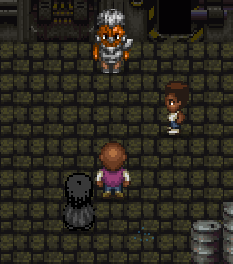
The party is represented in-game as a conga line of four sprites moving around a map. Generally, the sprite for Charles Barkley is always at the front, and he is the one that the player uses to instigate conversations and combat, if the game does not take away the player’s control for the sake of an in-game cutscene.
An important thing to note about the party is that all player characters share the same experience counter for the purpose of determining when they gain levels. There are some leftover designs in the game that suggested that there might have been plans for individual experience counters, which could have made the game more sophisticated.
The party members do not share gear however. This will be elaborated later.
STORY PROGRESSION:
Firstly, it has to be said that this section of the review would refrain from as many spoilers as possible.
The story progresses as one would expect of a JRPG. The main player character gets into trouble and has to gather allies and information on what to do next. This is mainly done by pursuing story-related quests, which party members, including the protagonist himself, would remind the player of – sometimes through fourth-wall-breaking statements.
The party is generally led by Barkley, who makes most of the decisions. However, there are not many decisions to make in the game, and what there are tend to be binary, with one of them typically leading to a game-over.
If the player is looking for a game where decisions matter in the outcome of the story, this is not it.
However, there are side quests in the game where the player can get involve in some silly scenarios where the player’s decisions only affect the fortunes of other people. The player does get something useful from concluding these scenarios, but their greater value lies in the humorous writing and references behind their mini-plots.
INVENTORY, GEAR & SHOPS:
The game makes use of an inventory that may be familiar to players that are used to JRPGs. It is not entirely a “pocket dimension” in which the player can store an unlimited number of items. For each type of item, the player appears to be able to stock only up to 99 of them (though there is rarely any need to reach this limit), but he/she can have as many types of items as he/she wants in the party’s inventory.
This, of course, can be abused to give the party a tremendous advantage in combat through having ample supplies of restoratives.
Each of the four party members generally uses his own type of gear. Only the Barkleys appear to share the use of gear that goes into their Body and Weapon slots. Baltheos and the Cyberdwarf, on the other hand, use specialized gear. However, gear that goes into their “Bling” slots is generally interchangeable between characters.
Shops are the main source of supplies for the party. Shops may either be actual shops with shopkeepers, in which case they usually sell gear in addition to supplies, or the Square-Enix-Goya vending machines, which seem to be at all kinds of places, shelling out supplies with absurd names like “Chicken Dews”.
The user interface of these shops makes use of charts to associate items on sale with the four party members. Simple symbols show whether a piece of gear would be an upgrade over which a character currently has or it would be obsolete.
However, it has to be said here that the game uses a very simple algorithm to determine whether a piece of gear is an “upgrade” or not. It merely calculates the net amount of points that go into a party member’s statistics, regardless of which has been altered. Fortunately, the user interface also contains a panel that shows the changes.
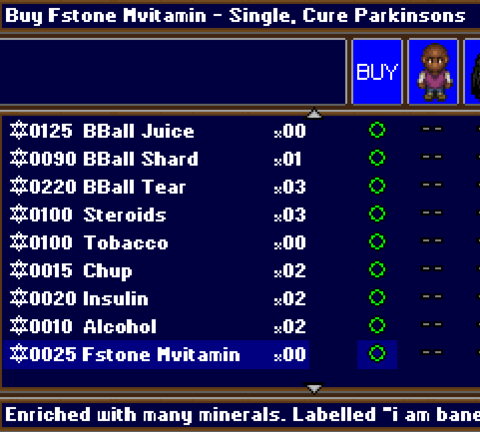
Unfortunately though, the user interface is deficient at helping the player to decide which items to sell. Only the names and quantities of items are shown; if the player has been using strategies that are oriented around swapping gear pieces, especially those for the “Bling” slot, he/she may have a hard time knowing which Bling items are obsolete when deciding which to sell.
STATISTICS:
The game makes use of conventional statistics that determine the capabilities and durability of participants in combat. However, it sheathes some of them with awkward names, such as “Brain” for the statistic that determines how resistant a character is to energy-based attacks and certain abilities.
The two most important statistics are Vitality and Battle Points (VP and BP) respectively. VPs are essentially hitpoints, and BP is the “energy” that is needed to perform special moves. It is in the player’s interest to keep both as high as possible for just about any fight. Furthermore, there are fewer means to replenish BP than there are for VP.
The game does its best to inform the player of the significance of different statistics and status effects through the inclusion of three items known as Battle Tomes, which are really in-game manuals.
COMBAT:
The combat in Shut Up and Jam: Gaiden would be familiar to players who are used to old-school JRPGs. Two parties of one or more characters (usually the latter) meet each other and attempt to drain the hitpoints of the other party to zero.
In the case of the player characters, having their hitpoints drained to zero does not put them down permanently. Fallen characters can be revived with certain items and abilities. However, the opposing side does not have the same luxury.
In other words, Shut Up and Jam: Gaiden would not be doing anything to alleviate the issue in old-school JRPGs which is that many battles tend to be attrition-oriented.
The combat in the game is turn-based, and in the simplest manner possible. Each party of combatants makes their moves in an alternating manner, though the members of either party can make their own moves in any particular order. This is of more use to the player than the A.I. routines that control the enemy party (and which often make mistakes).
The statistics that have been mentioned earlier are mainly relevant to combat. Many abilities, both those of the player characters and enemies, alter the Guard, Brain and Power ratings of participants to make them weaker, stronger, tougher or some other combination of changes.
Indeed, certain fights become a lot easier if enemies can be softened up with de-buffs or party members made tougher to take more hits.
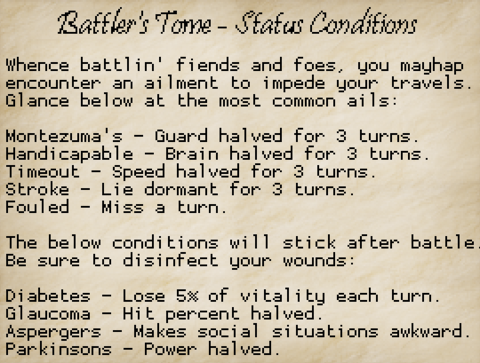
In-game, both Barkleys are intended as damage-dealers, though Charles is more of a heavy-hitter while Hoopz has certain regular attacks that can be used against multiple targets.
Speaking of regular attacks, for better or worse, there are some regular attacks that require the player to enter control inputs according to visual indicators. These are the other reflex-dependent gameplay elements that have been alluded to earlier. Charles Barkley, in particular, has all of his regular attacks work in such a manner, which makes him more difficult to learn and master than the other characters.
Of course, one can argue that these input-dependent regular attacks are far less intrusive than QTEs and the player is not too badly punished for fumbling in them. In fact, the player is rewarded for doing well at timing the various button presses with high damage output from the player characters.
However, this still would not please players who have the view that planning should be the number one factor in combat encounters.
Of all the characters, it is perhaps the Cyberdwarf that has the most interesting regular attacks. In fact, his regular attack is his main means of inflicting damage, because most of his abilities relegate him to the secondary role of a healer due to most of his abilities.
Upon having the Cyberdwarf start his regular attacks, the player is given a small amount of time to enter a combination of inputs. These inputs have the Cyberdwarf performing pugilistic moves on the target. Interestingly, the player can also add a finisher, which does not inflict any damage (oddly enough) but applies a debuff instead. This is perhaps the most convincingly refreshing element of the game.
SPECIAL ABILITIES & BPS:
Each of the four characters has his own special abilities. These abilities grant them a special edge in battle that items cannot provide. However, this advantage is balanced by their costs in Battle Points, which are consumed whenever special abilities are used.
Charles Barkley’s abilities power himself up, pretty much landing him in the role of a tank. Baltheos, oddly enough, has abilities that are oriented around placing de-buffs on enemies (one of which is devastating). Cyberdwarf’s healing abilities have been mentioned earlier, while Hoopz’s abilities are practically damage-dealers.
Although an astute player would notice that he/she can hoard a lot of BP-increasing items to keep the party topped up, he/she cannot use them so easily during combat; spending a turn on using them comes with considerable opportunity costs.
ENEMIES:
The enemies in this game are humorously outrageous. Most of them appear to be constructs that are made of basketballs and other basketball paraphernalia. For example, there are bulbous spiders made of basketballs, of all things, and constructs that resemble giant referee whistles. Heck, there are even robot referees with fabulous hair and buzz-saws for legs.
Other silly sights include giant Gatorade bottles that fire defective cogs at the player characters (which is perhaps a poke at certain defects in the associated real-world products).
Perhaps the most hilarious enemies to be encountered in the game are undead basketball players. Seeing what appear to be modified sprites from 16-bit basketball games can be amusing. That their attack moves and special abilities are actually basketball-related is even more entertaining.
For example, there is a ghostly enemy that holds two basketballs in its arms. It uses these basketballs for rather wimpy attacks. However, once it is out of basketballs, it resorts to much nastier and more appropriately ghostly attacks – before somehow getting basketballs in its hands again.
In fact, some of the mini-bosses in the game are basketball celebrities, albeit (usually) represented in-game as identical-looking brutes in jerseys.
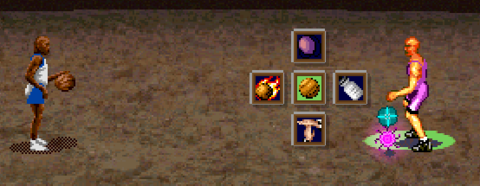
Silly appearances aside, there may be some issues with the challenge posed by enemies.
Seemingly, the game resorts to increases in their statistics as the game progresses in order to raise the challenge. Therefore, a certain enemy type that a player has seen earlier in the game might be tougher when encountered later on, but it will not be any smarter. However, its behaviour remained the same.
If the player has not kept up with the arms race, i.e. making sure that the party is gaining levels and more powerful gear, he/she might find the coming enemies to be too powerful. At best, he/she may have to struggle through these fights by expending many turns having party members use healing items on each other.
Yet, if he/she had been studiously making sure that the party is using the latest gear to appear in shops (and newer is usually better), the enemies – even the bosses – that would be encountered later might seem like a breeze.
This happens to occur after a certain point in the game when Charles Barkley has obtained some very powerful basketball-related items.
Enemies have hitpoint counters that are visible to the player, but their BP counters are hidden. They do use BPs for special attacks, and they do eventually run out of BPs. This makes battles of attrition, if the player cannot avoid these, more manageable. However, certain bosses are capable of restoring their BPs (and perhaps hitpoints as well).
PUMP:
Like the JRPGs that inspired the game, Shut Up and Jam: Gaiden has a game-saving system that requires the player to make use of save-points. Unfortunately, unlike the save-points in the old-school JRPG games, the ones in this game are quite a hassle.
They take on the form of sentient truck pumps (of all things) that float in mid-air or are adjacent to surfaces that should not be able to support truck pumps, such as wire fences. Interacting with one has the player wading through the ramblings of an ardent fan of JRPGs before he/she can actually save the game session.
Even if the player is not interested in the drivel, he/she still has to skip through six or so pages of ranting, which can be very annoying.
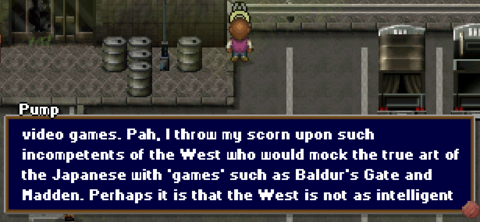
IN-GAME SPRITES:
Although the game may evoke nostalgia among those who remember the old-school JRPGs that inspired this game, the players may notice that some of the game’s visual designs cannot even hold a candle up to the latter.
Firstly, the sprites for the characters while they are moving around as a party are quite static, lacking any animations beyond just mere movement. Considering that old-school JRPGs such as Final Fantasy VI had cuter and more amusingly animated sprites, veterans of these more venerable games might scoff at the simplicity of the sprites in Shut Up and Jam: Gaiden.
Some of the sprites that are used in combat are particularly ugly and crude. For example, there is an optional boss in the game that is hideously ugly, as if it belongs more to an 8-bit game than a 16-bit one. Of course, one could argue that this was deliberate and that the ugly sprite is actually another reference to old-school games. However, if it is, then it may be an obscure reference.
Certain sprites have hilarious alternate frames. For example, there are enemies that are exaggeratedly evil and brutish basketball players. As a special ability, these enemies can collapse their bodies to toughen themselves up and heal (in return for the temporary loss of offensive capabilities). In this form, they use a sprite that looks so entertainingly absurd.
OTHER MENTIONS:
Game Maker may be associated with often technically uncomplicated JRPG-inspired games, but its object-based programming features do allow for some other forms of gameplay. This can be seen in some of the side distractions within the game.
For example, there is a side distraction that has the player figuring out a tile-swapping puzzle.
There are some environment-based puzzles in the game, though these are simpler than one would think. For example, there is a scenario where the player must avoid patches of hazardous substances while navigating through a cave. Such a scenario may seem standard-fare to players that are familiar with games that are oriented around exploration.
However, a scenario like this would be used to showcase the game’s off-kilter humour. Referring to the example again, the hazardous substances are piles of sugar. Apparently, diabetes is a particularly dangerous disease in the game’s fictional world and sugar is treated like radioactive waste.
The game also has a few easter eggs for players that are thorough. Curious players would be able to come across most of these easter eggs. Even if a player uses a guide to find them, the spoilers would not be enough to detract from their humour.
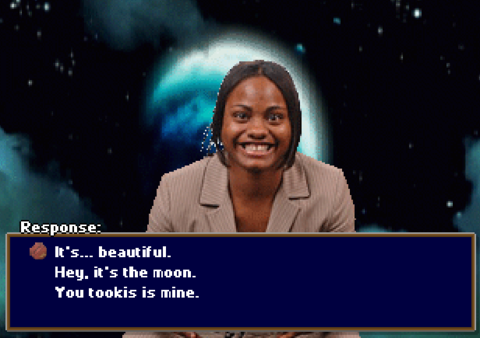
SOUND DESIGNS:
Most of the sounds are composed by Chef Boyardee, a group of indie music designers whose name complicates literature research on them.
That complaint aside, Chef Boyardee is apparently one of those groups that are enamoured with remixing and altering musical soundtracks of yore. This can be apparently heard in the music soundtracks for the game, most of which are remixed versions of those heard in Final Fantasy VI. There is also the main menu music, which is a remix of the theme song for Space Jam (and the remix is arguably more exciting to listen to).
One could argue that Chef Boyardee is being disingenuous by using others’ music as the foundation for their own, but most of the results are still quite pleasing to the ears anyway.
(The only soundtrack that has not be remixed is “Eternity”, a certain song in Blue Dragon that is sung by Ian Gillan. Perhaps Tales of Games and Chef Boyardee deserve censure for the straight lifting.)
Most of the sound effects in the game are either electronic noises made to sound like basketball-associated noises or actual basketball-related noises corrupted to sound 16-bit. It is not clear which route that Chef Boyardee took.
There are also sound effects for 16-bit gunfire, likely to have been lifted from a game during that era of video games. Of course, one could argue that even if this was the case, gunfire noises were as pervasively used back then as they are now that this should not be construed as an issue of plagiarism.
CONCLUSION:
In all honesty and fairness, Shut Up and Jam: Gaiden takes many of its elements from many other games, with few original designs that it can call its own (though it does have these). However, Tales of Games had not slapped together some half-hearted piece of work that reeks of plagiarism. Much of the game can be argued to be earnest homage, especially considering that it is freeware.
Most importantly, the game’s creators have worked together a plot and presentation that is so outrageously silly, it would take a player that is especially shriven of any sense of humour to despise this game for what it has done.

